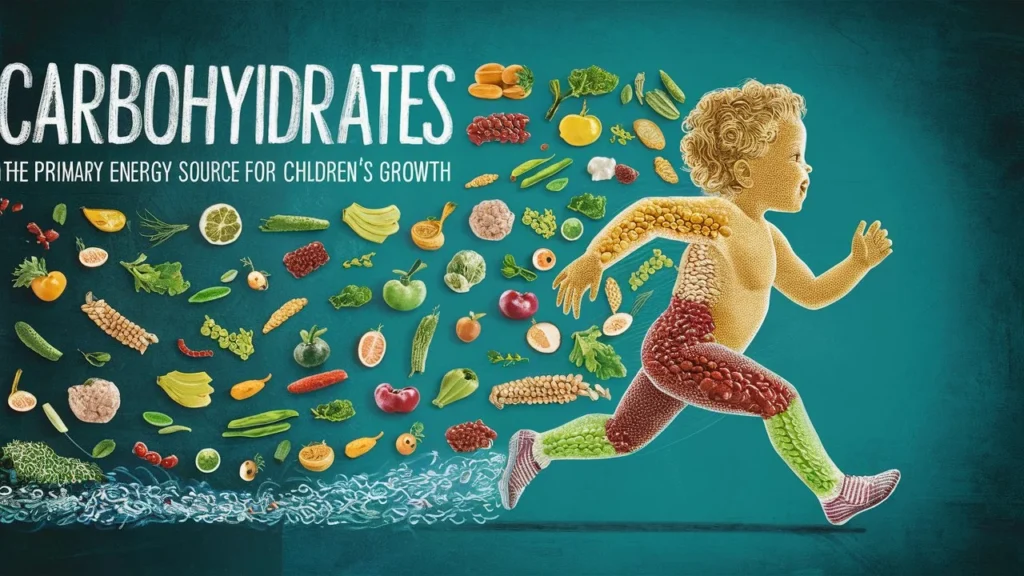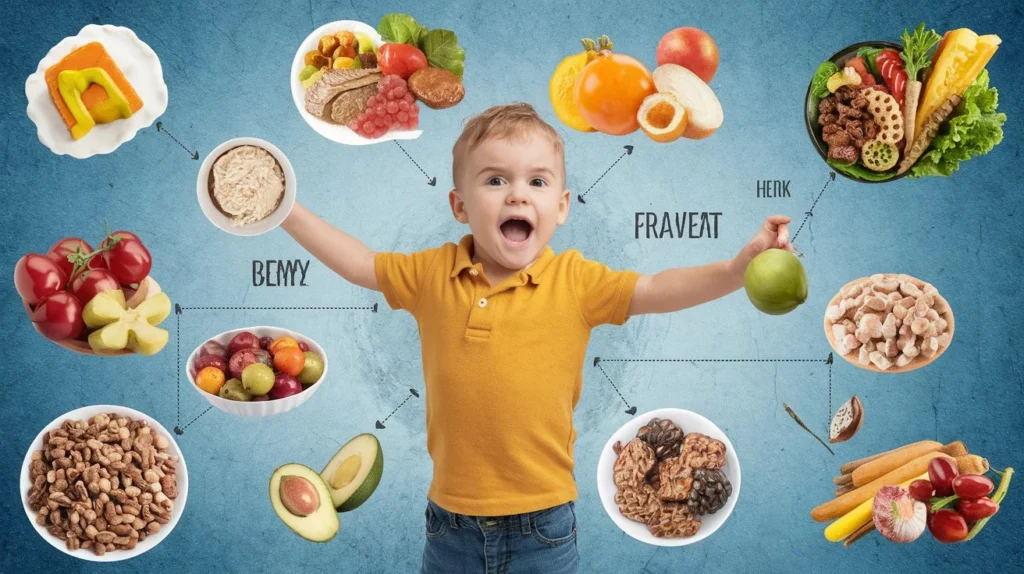The Role of Proteins and Carbohydrates
Table of Contents
Introduction
Proper nutrition is crucial for children’s physical and cognitive development. Among the macronutrients, proteins and carbohydrates play pivotal roles in ensuring healthy growth, providing the necessary energy and building blocks for bodily functions. While proteins are essential for building and repairing tissues, carbohydrates serve as the primary energy source that fuels all of the body’s activities, including brain function. Understanding the role of these macronutrients helps parents provide their children with a well-balanced diet to support their growth and development. This article explores the distinct functions of proteins and carbohydrates, their significance in various stages of childhood, and practical ways to incorporate these nutrients into everyday meals.
1. The Importance of Proteins in Children’s Growth

Proteins are often referred to as the body’s “building blocks.” They are vital for the development of muscles, bones, organs, and other tissues. Proteins also play a role in immune function, making them essential for maintaining overall health. Let’s explore the specific ways proteins contribute to children’s growth.
1.1 Role of Proteins in Tissue Growth and Repair
Proteins consist of amino acids, which are necessary for the development of new tissues and the repair of damaged ones. During childhood, rapid growth occurs, especially in infancy, early childhood, and adolescence, making protein intake critical. Insufficient protein can lead to stunted growth, weakened immune systems, and other developmental delays.
1.2 Protein and Cognitive Development
Proteins are involved in the production of neurotransmitters and enzymes that support brain function. Amino acids like tryptophan and tyrosine are critical in producing serotonin and dopamine, which regulate mood, concentration, and learning. A deficiency in protein during childhood can hinder cognitive development and lead to issues such as reduced concentration, memory problems, and learning difficulties.
1.3 Recommended Daily Protein Intake by Age
The amount of protein a child needs depends on their age, weight, and level of physical activity. The U.S. Department of Agriculture (USDA) provides guidelines for daily protein intake for children.
Table 1: Recommended Daily Protein Intake for Children (USDA)
| Age Group | Recommended Daily Protein Intake (grams/day) |
|---|---|
| 1-3 years | 13 g |
| 4-8 years | 19 g |
| 9-13 years | 34 g |
| 14-18 years (girls) | 46 g |
| 14-18 years (boys) | 52 g |
1.4 Best Sources of Protein for Children
- Animal Proteins: Lean meats, chicken, fish, eggs, dairy products (milk, yogurt, cheese).
- Plant-Based Proteins: Beans, lentils, quinoa, tofu, tempeh, nuts, and seeds.
Parents can ensure their children meet their daily protein requirements by including a variety of protein-rich foods in their meals.
2. Carbohydrates: The Primary Energy Source

Carbohydrates often get a bad reputation, but they are an essential component of a balanced diet, especially for growing children. Carbohydrates provide the energy necessary for physical activities, brain function, and overall metabolism.
2.1 How Carbohydrates Fuel Growth and Development
Carbohydrates are broken down into glucose, which is the body’s preferred energy source. Children, who are often more active than adults, require a steady supply of carbohydrates to meet their energy needs. Carbohydrates also play a role in brain development, as glucose is essential for brain function and learning.
2.2 Types of Carbohydrates and Their Impact on Health
There are two main types of carbohydrates: simple carbohydrates (sugars) and complex carbohydrates (starches and fibers). While both types provide energy, complex carbohydrates are more beneficial for long-term health as they provide sustained energy and are often accompanied by fiber, which aids digestion.
- Simple Carbohydrates: Found in sugars, sweets, and many processed foods. These provide quick energy but are often devoid of essential nutrients.
- Complex Carbohydrates: Found in whole grains, vegetables, and legumes. These provide longer-lasting energy and contribute to overall health.
Table 2: Simple vs. Complex Carbohydrates
| Type of Carbohydrate | Examples | Benefits/Drawbacks |
|---|---|---|
| Simple Carbohydrates | Sugary snacks, candy, soda | Quick energy but often lead to energy crashes |
| Complex Carbohydrates | Whole grains, vegetables, legumes | Provide sustained energy, rich in nutrients |
2.3 Recommended Daily Carbohydrate Intake for Children
According to the USDA, carbohydrates should make up 45-65% of a child’s daily caloric intake. This ensures they have enough energy for growth, learning, and physical activities.
3. Balancing Proteins and Carbohydrates for Optimal Growth
While both proteins and carbohydrates are essential, balancing these macronutrients is key to supporting healthy growth in children. A diet that is too heavy in carbohydrates, especially simple carbs, can lead to energy imbalances and potential weight issues, while insufficient protein can impair tissue development and cognitive growth.
3.1 Creating Balanced Meals for Children
Parents should aim to provide meals that contain a balance of proteins, carbohydrates, and healthy fats. For instance:
- Breakfast: Whole-grain toast with scrambled eggs and a piece of fruit.
- Lunch: Grilled chicken with brown rice and steamed vegetables.
- Dinner: Lentil soup with quinoa and a side salad.
3.2 Practical Tips for Encouraging Healthy Eating Habits
- Incorporate Variety: Offer a wide variety of protein and carbohydrate sources to ensure a broad spectrum of nutrients.
- Limit Processed Foods: Avoid overly processed carbohydrates, such as sugary cereals and white bread.
- Use Healthy Cooking Methods: Opt for baking, grilling, or steaming instead of frying.
Table 3: Balanced Meal Ideas for Children
| Meal | Protein Source | Carbohydrate Source | Additional Nutrients |
|---|---|---|---|
| Breakfast | Scrambled eggs | Whole-grain toast | Fiber, Vitamins A, B (from fruits) |
| Lunch | Grilled chicken | Brown rice | Iron, Fiber, Antioxidants (from vegetables) |
| Dinner | Lentil soup | Quinoa | Folate, Magnesium (from legumes) |
4. The Impact of Protein and Carbohydrate Deficiencies

Insufficient intake of proteins and carbohydrates can lead to developmental delays and health issues. Both short-term and long-term effects are concerning, making it essential for parents to understand the importance of meeting nutritional needs.
4.1 Protein Deficiency and Its Effects
- Growth Delays: Without enough protein, children may experience stunted growth, weakened muscles, and delayed puberty.
- Weakened Immune System: Protein deficiency can impair the immune system, making children more susceptible to infections.
- Cognitive Impairment: Lack of protein may affect neurotransmitter production, leading to learning difficulties and memory problems.
4.2 Carbohydrate Deficiency and Its Effects
- Low Energy Levels: Without adequate carbohydrates, children may feel tired, weak, and unable to focus.
- Poor Brain Function: Carbohydrates are the brain’s main fuel, so a deficiency can impair learning and memory retention.
- Growth Impairment: In severe cases, lack of carbohydrates can lead to energy imbalances that affect overall growth.
Table 4: Potential Deficiencies and Symptoms
| Nutrient Deficiency | Symptoms | Long-Term Effects |
|---|---|---|
| Protein Deficiency | Stunted growth, weak muscles, fatigue | Developmental delays, impaired immunity |
| Carbohydrate Deficiency | Low energy, difficulty concentrating | Growth impairment, cognitive issues |
5. The Role of Proteins and Carbohydrates in Childhood Obesity
While proteins and carbohydrates are essential, excessive intake, especially of unhealthy carbohydrates, can contribute to childhood obesity. Processed foods high in simple sugars can lead to excessive calorie intake, weight gain, and metabolic issues.
5.1 Managing Carbohydrate Intake
Focusing on complex carbohydrates like whole grains, fruits, and vegetables can help manage children’s weight and provide long-lasting energy.
5.2 Proteins and Satiety
Proteins can promote a sense of fullness, reducing the likelihood of overeating. Incorporating lean proteins into meals can help maintain a healthy weight and prevent obesity.
Table 5: Common Sources of Unhealthy Carbohydrates in Children’s Diets
| Unhealthy Carbohydrate Sources | Common Examples | Health Risks |
|---|---|---|
| Sugary Snacks and Beverages | Sodas, candy, cookies | Weight gain, energy crashes, insulin spikes |
| Refined Grains | White bread, white pasta | Reduced fiber intake, rapid blood sugar spikes |
FAQ Section
Q1: How much protein should my child eat daily?
A1: The recommended daily intake varies by age. For example, children aged 4-8 should consume around 19 grams of protein daily, while teens require more.
Q2: Can too much protein be harmful to children?
A2: While protein is essential, excessive intake can lead to digestive issues and strain on the kidneys. Balance is key.
Q3: Are carbohydrates bad for children?
A3: No, carbohydrates are essential for energy, especially complex carbs like whole grains and vegetables. However, simple carbs (sugary foods) should be limited.
Q4: How can I encourage my child to eat more protein?
A4: Incorporate protein-rich foods into familiar meals, like adding eggs to breakfast or beans to soups and stews.
Conclusion
Both proteins and carbohydrates are fundamental to children’s growth and development. Proteins support the building and repairing of tissues, while carbohydrates provide the energy needed for physical activity and cognitive function. A balanced diet that incorporates these nutrients in the right amounts, with a focus on healthy sources, ensures that children grow up strong, healthy, and ready to face the challenges of everyday life. Parents play a crucial role in guiding their children’s eating habits by offering balanced meals, limiting processed foods, and educating them about the importance of nutrition.
References
- U.S. Department of Agriculture. (2023). Protein Foods: USDA Dietary Guidelines.
- American Academy of Pediatrics. (2022). Carbohydrates and Child Nutrition.
- National Institutes of Health. (2021). Proteins and Cognitive Development in Children.
- World Health Organization. (2021). Child Growth and Nutrient Intake.
- Harvard T.H. Chan School of Public Health. (2022). Healthy Eating Plate for Kids.







